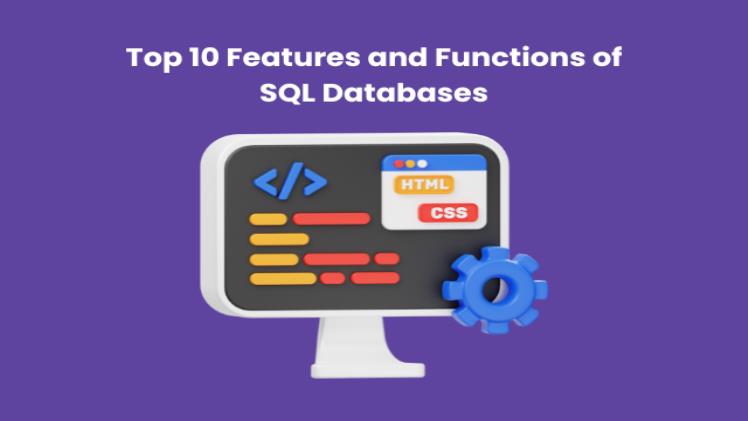Top 10 Features and Functions of SQL Databases

In data management, SQL databases stand out as a cornerstone technology. Structured Query Language, or SQL, is a powerful tool for managing and manipulating relational databases. Whether you are a seasoned database administrator or just embarking on an SQL Course, understanding the key features and functions of SQL databases is essential. In this blog, we’ll delve into the top 10 features that make SQL Database indispensable in the realm of data management.
Table of Contents
- Data Integrity and Constraints
- Querying with SELECT Statements
- Data Modification with INSERT, UPDATE, and DELETE
- Joins for Data Combining
- Indexes for Performance Optimization
- Transactions for Data Consistency
- Stored Procedures and Functions
- Data Security through Authentication and Authorization
- Backup and Recovery Options
- Aggregation Functions for Data Analysis
- Conclusion
Data Integrity and Constraints
The capacity to ensure data integrity via constraints is fundamental to SQL databases. To ensure the data you add to your SQL database is valid, you may use restrictions like PRIMARY KEY, FOREIGN KEY, UNIQUE, and CHECK. By doing so, we may build a strong and integrated database structure while ensuring that the data remains accurate and facilitating interactions across tables.
Querying with SELECT Statements
The SELECT statement is an essential part of every SQL database. Users may obtain data from several tables according to predefined criteria using this robust function. A crucial skill in any SQL training is understanding how to build SELECT statements. These statements allow users to retrieve the information they need from huge databases.
Data Modification with INSERT, UPDATE, and DELETE
Users can alter data smoothly in SQL databases. Using the INSERT, UPDATE, and DELETE statements, you may insert new records, modify existing ones, and delete records, respectively. This set of three instructions allows you to maintain current and correct data.
Joins for Data Combining
Data is often spread out over several tables in relational databases. The JOIN operation in SQL enables users to merge information from several tables with a common field. Using this function, you may build sophisticated queries that access various database sections.
Indexes for Performance Optimisation
Optimal database performance is dependent on efficient data retrieval. SQL databases use indexes to speed up data retrieval and search. An important factor to consider when dealing with big datasets is the performance of SELECT queries; users may greatly improve this speed by building indexes on certain columns.
Transactions for Data Consistency
When it comes to ensuring data integrity, SQL databases shine with their transaction support. A sequence of SQL statements is performed in a unified fashion using transactions. To keep the database consistent and intact, the whole transaction is rolled back if any portion fails.
Stored Procedures and Functions
The development of stored procedures and functions is made possible by SQL databases. Users may encapsulate complicated logic with these precompiled sets of one or more SQL statements, promoting code reusability and easing maintenance. Learning stored procedures and functions in an SQL course may make database operations more efficient and manageable.
Data Security through Authentication and Authorisation
By using strong authentication and permission systems, SQL databases place data security as a top priority. Each user has their own set of permissions to manage their access to the database. This protects sensitive information from unauthorised access by ensuring that only authorised users may read or edit specified data.
Backup and Recovery Options
Due to the catastrophic nature of data loss, SQL databases must have strong backup and recovery capabilities. Users may establish restoration points and retrieve data using backup processes such as complete and incremental backups in case of system problems, failures, or other unanticipated events.
Aggregation Functions for Data Analysis
With aggregation functions such as COUNT, SUM, AVG, MAX, and MIN, SQL databases make it easy to analyse data. Users can extract useful information from massive datasets with the help of these functions, which summarise and compute statistical measures. These functions are very helpful for aspiring data professionals taking an SQL course as they teach the fundamentals of data analysis.
Conclusion
Everyone taking an SQL course or working in data analytics must have a solid grasp of SQL databases and all the features and operations they provide because they are fundamental to data management. From maintaining data integrity to offering strong querying capabilities and solid security measures, SQL databases provide a full range of tools for effective and efficient data administration. The significance of SQL databases in realising data’s full potential will persist even as technology advances. Understanding SQL database is worthwhile for everybody, from beginners to seasoned pros.



